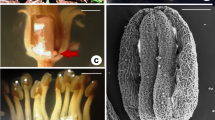Abstract
Ixianthes retzioides is a rare, moderately sized, shrub with large yellow flowers that are lined with glandular trichomes. Preliminary analysis indicates that the trichomes secrete a complex mixture of lipids. Floral morphology suggests thatIxianthes should be pollinated by a large oil-collecting bee, yet only one possible candidate,Rediviva “gig”, is known and it occurs outside of the distributional range ofIxianthes. Despite observations ofIxianthes at different sites in different years, no oil-collecting bee has been observed visiting the flowers. This together with low fruit and seed set at the main study site suggests thatIxianthes has lost, at least locally, its specialized pollinator. Plants are self-compatible and set a limited amount of seed as a result of visits by pollen-collecting bees.
Similar content being viewed by others
References
Armbruster, W. S., 1984: The role of resin in angiosperm pollination. Ecological and chemical considerations. — Amer. J. Bot.71: 1149–1160.
Buchmann, S. L., 1987: The ecology of oil flowers and their bees. — Annu. Rev. Ecol. Syst.18: 343–369.
Gould, S. J., Vrba, E. S., 1982: Exaptation — a missing term in the science of form. — Paleobiology8: 4–15.
Howe, H. F., 1984: Constraints on the evolution of mutualisms. — Amer. Naturalist123: 764–777.
—, 1985: Gomphothere fruits: a critique. — Amer. Naturalist125: 853–865.
Janzen, D. H., 1980: When is it coevolution? — Evolution34: 611–612.
—, 1983: Dispersal of seeds by vertebrate guts. — InFutuyma, D. J., Slatkin, M., (Eds): Coevolution, pp. 232–262. — Sunderland: Sinauer.
—,Martin, P., 1982: Neotropical anachronisms: what the gomphotheres ate. — Science215: 19–27.
Manning, J. C., Brothers, D. J., 1986: Floral relations of four species ofRediviva in Natal (Hymenoptera: Apoidea: Mellittidae (sic)). — J. Entomol. Soc. S Africa49: 107–114.
Pijl, L. van der, Dodson, C. H., 1966: Orchid flowers. Their pollination and evolution. — Coral Gables: University of Miami Press.
Simpson, P. B., Neff, J. L., Dieringer, G., 1990: The production of floral oils byMonttea (Scrophulariaceae) and the function of tarsal pads inCentris bees. — Pl. Syst. Evol.173: 209–222.
Steiner, K. E., 1987: Oil-producing orchids and oil-collecting bees in southern Africa. — Abstr. Ann. Congr. South African Assoc. Bot., Durban, p. 81.
—, 1989: The pollination ofDisperis (Orchidaceae) by oil-collecting bees in southern Africa. — Lindleyana4: 164–183.
—, 1990: TheDiascia (Scrophulariaceae) window: an orientation cue for oil-collecting bees. — Bot. J. Linn. Soc.102: 175–195.
—,Whitehead, V. B., 1988: The association between oil-producing flowers and oil-collecting bees in the Drakensberg of southern Africa. — Monogr. Syst. Bot. Missouri Bot. Gard.25: 259–277.
—, —, 1990: Pollinator adaptation to oil-secreting flowers—Rediviva andDiascia. — Evolution44: 1701–1707.
—, —, 1991a: Oil flowers and oil bees: further evidence for pollinator adaptation. — Evolution45: 1493–1501.
—, —, 1991b: The pollination ofBowkeria andAnastrabe by oil-collecting bees. — Abstr. Ann. Congr. South African Assoc. Bot., Pietermaritzburg, p. 80.
Vogel, S., 1974: Ölblumen und ölsammelnde Bienen. — Trop. Subtrop. Pflanzenwelt7: 1–267.
—,Machado, I. C., 1991: Pollination of four sympatric species ofAngelonia (Scrophulariaceae) by oil-collecting bees in NE Brazil. — Pl. Syst. Evol.178: 153–178.
Wheelwright, N. T., Orians, G. H., 1982: Seed dispersal by animals: contrasts with pollen dispersal, problems of terminology, and constraints on coevolution. — Amer. Naturalist119: 402–413.
Whitehead, V. B., Schelpe, E. A., Anthony, N. C., 1984: The bee,Rediviva longimanus Michener (Apoidea: Melittidae), collecting pollen and oil fromDiascia longicornis (Thunb.)Druce (Scrophulariaceae). — S African J. Sci.80: 286.
Author information
Authors and Affiliations
Rights and permissions
About this article
Cite this article
Steiner, K.E. HasIxianthes (Scrophulariaceae) lost its special bee?. Pl Syst Evol 185, 7–16 (1993). https://doi.org/10.1007/BF00937717
Received:
Revised:
Accepted:
Issue Date:
DOI: https://doi.org/10.1007/BF00937717




